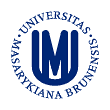



Pulmonary atresia with ventricular septal defect is an extreme form of tetralogy of Fallot. There is no flow through the pulmonic valve. The mediastinal portions of the pulmonary arteries may be hypoplastic or atretic as well. As the ductus closes in the first days of life the infant is dependent on blood flow through the aortopulmonary collateral arteries. These usually arise from the thoracic aorta. If the collateral arteries are small the infant is markedly cyanotic.
Syndrom of absence of the pulmonary valve is a rare anomaly associated with tetralogy of Fallot. There is a narrow annulus, no valve and marked poststenotic dilatation of the pulmonary arteries. The dilated arteries compress the bronchi, the affected children present with major respiratory problems. Absent pulmonary valve is associated with Di George syndrome.
Pulmonary atresia with ventricular septal defect (extreme variant of the
tetralogy of Fallot):
 Atresia of the pulmonary artery, Macro, autopsy (73169)
Atresia of the pulmonary artery, Macro, autopsy (73169)
 Atresia of the pulmonary artery, Macro, autopsy (73170)
Atresia of the pulmonary artery, Macro, autopsy (73170)
 Atresia of the pulmonary artery, Macro, autopsy (73171)
Atresia of the pulmonary artery, Macro, autopsy (73171)
Another case of pulmonary atresia with ventricular septal defect:
 Atresia of the pulmonary artery, Macro, autopsy (73172)
Atresia of the pulmonary artery, Macro, autopsy (73172)
 Atresia of the pulmonary artery, Macro, autopsy (73173)
Atresia of the pulmonary artery, Macro, autopsy (73173)
 Atresia of the pulmonary artery, Macro, autopsy (73174)
Atresia of the pulmonary artery, Macro, autopsy (73174)
 Atresia of the pulmonary artery, Macro, autopsy (73175)
Atresia of the pulmonary artery, Macro, autopsy (73175)
Tetralogy of Fallot with absent pulmonary valve:
 Tetralogy of Fallot, Macro, autopsy (73219)
Tetralogy of Fallot, Macro, autopsy (73219)
 Tetralogy of Fallot, Macro, autopsy (73220)
Tetralogy of Fallot, Macro, autopsy (73220)
 Tetralogy of Fallot, Macro, autopsy (73221)
Tetralogy of Fallot, Macro, autopsy (73221)
 Tetralogy of Fallot, Macro, autopsy (73222)
Tetralogy of Fallot, Macro, autopsy (73222)
 Tetralogy of Fallot, Macro, autopsy (73223)
Tetralogy of Fallot, Macro, autopsy (73223)
 Tetralogy of Fallot, Macro, autopsy (73224)
Tetralogy of Fallot, Macro, autopsy (73224)
 Tetralogy of Fallot, Macro, autopsy (73225)
Tetralogy of Fallot, Macro, autopsy (73225)
Tetralogy of Fallot, surgery:
 Tetralogy of Fallot, surgery, Macro, autopsy (73649)
Tetralogy of Fallot, surgery, Macro, autopsy (73649)
 Tetralogy of Fallot, surgery, Macro, autopsy (73650)
Tetralogy of Fallot, surgery, Macro, autopsy (73650)
Tetralogy of Fallot:
 Tetralogy of Fallot, Macro, autopsy (73651)
Tetralogy of Fallot, Macro, autopsy (73651)
 Tetralogy of Fallot, Macro, autopsy (73652)
Tetralogy of Fallot, Macro, autopsy (73652)
Tetralogy of Fallot:
 Tetralogy of Fallot, Macro, autopsy (73653)
Tetralogy of Fallot, Macro, autopsy (73653)
Tetralogy of Fallot, immature newborn:
 Tetralogy of Fallot, Macro, autopsy (73979)
Tetralogy of Fallot, Macro, autopsy (73979)
 Tetralogy of Fallot, Macro, autopsy (73980)
Tetralogy of Fallot, Macro, autopsy (73980)
 Tetralogy of Fallot, Macro, autopsy (73981)
Tetralogy of Fallot, Macro, autopsy (73981)
 Tetralogy of Fallot, Macro, autopsy (73982)
Tetralogy of Fallot, Macro, autopsy (73982)